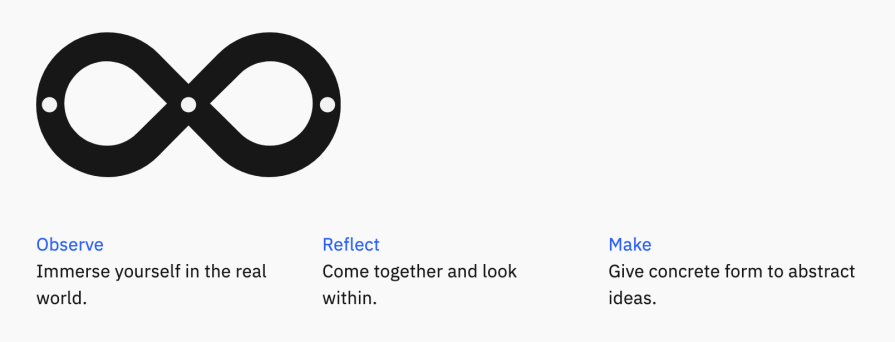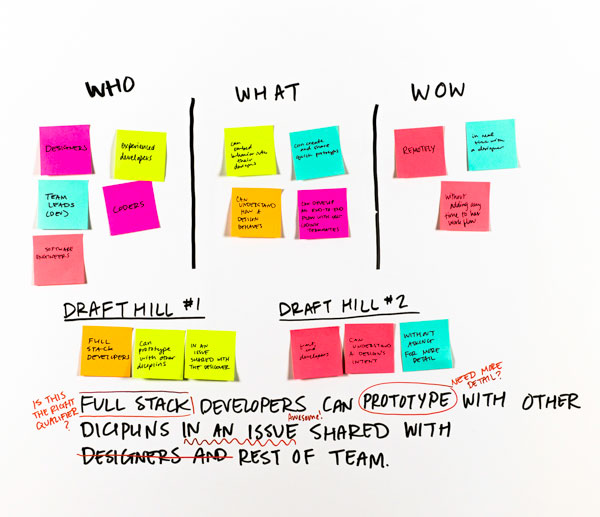If you think of an enterprise, you might picture a large multinational organization, with multiple business units and old offices with cubicles. Enterprises are often associated with corporate culture and a bureaucratic hierarchy, which often results in siloed teams and slow decision making.

When enterprise teams rely on strict rules and complicated approval processes, this leads to bottlenecks and inefficient workflows. When you add on the misunderstood role of product design, it’s a challenge for enterprises to effectively develop products that put the user’s experience at the forefront.
Enterprise design thinking is a methodology developed by IBM for unifying teams around a single product development approach. It emphasizes the importance of forming a human connection among stakeholders, customers, and end users and focuses on user experience rather than technology or features.
An enterprise comes with unique challenges that may not be as present in small and medium-sized businesses (SMBs). Enterprise design thinking aims to align teams around a common goal and support them in working more efficiently while keeping their work centered around people.
Maybe you have some challenges with product design at your company. If that’s you, let’s talk about designing in an enterprise, the enterprise design thinking framework, and strategies to apply enterprise design thinking to your own enterprise.
Let’s understand what it’s like to design for an enterprise because it comes with a set of unique challenges. Enterprises consist of numerous teams, processes, and systems.
These siloed teams often rely on outdated ways of working. This adds complexity to your design process because designers have to manage relationships with many stakeholders, such as product managers and developers. Each stakeholder may have different objectives and priorities, causing misalignment within the organization. And when stakeholders aren’t aligned to the same objectives, this delays progress and causes tension across teams.
The nature of designing enterprise products is also significantly different from consumer product design. In many cases, the customer purchasing the product isn’t the same person as the end user. Designers have to navigate this complex environment, involving multiple layers of stakeholders and decision-makers, to truly understand their users’ needs and design experiences that are tailored toward them. This process can be time consuming and involve a lot of negotiation and compromise.
So what can enterprise designers do to align stakeholders, break down silos, and gather user insights so that they can design experiences that engage users and deliver better business outcomes? There’s no silver bullet, but the enterprise design thinking framework will help.
IBM’s enterprise design thinking is a framework to help organizations apply design thinking at scale. It’s meant not just for designers, but for the entire team to adopt as a mindset when building products. Enterprise design thinking is a way to approach problem solving when you’re working in complex spaces that include uncertainty, constraints, and competing stakeholder priorities. It aligns teams around a central objective and gives them the tools to move efficiently toward creating human-centered solutions.
The framework consists of three parts: the Principles, the Loop, and the Keys, as they are referred to. They provide the guidance to adopt the framework, the drive to move forward, and the tools to keep teams aligned. Let’s take a look at each to understand how they contribute to the framework overall.
To successfully implement a design thinking framework within an enterprise organization, first you need to understand the purpose and values of the framework. The Principles guide teams to see problems and solutions as an ongoing conversation by focusing on user outcomes instead of features and functionality.
You can focus on user outcomes by identifying who your users are and getting to know them as people with ever-evolving needs. Through building empathy and understanding, teams can design experiences that lead to positive user outcomes:

What’s more, the framework encourages teams to treat everything as a prototype. Instead of aiming for perfection, product development is a continuous conversation with your users — their needs evolve and technologies advance. By setting measurable user outcome metrics, you can evaluate the effectiveness of your solutions and restlessly reinvent your solutions to make them better each time.
Finally, enterprise design thinking empowers diverse teams to act faster and achieve a desired outcome. In an enterprise, teams often consist of people from different cultural, educational, and professional backgrounds, possibly located in different time zones, and of a wide range of ages and ethnicities.
Enterprise design thinking highlights the significance of having diversity of perspective and expertise bewcause it lends itself to generating breakthrough ideas. When a diverse team has the agency to act on their own and make operational decisions, they’re able to deliver user outcomes faster without having to rely on leadership for approval.
The driving force behind the Principles of restless reinvention is the Loop. It’s the continuous cycle of observing, reflecting, and making that keeps teams progressing through uncertainty and ambiguity. Designers don’t just solve problems for today; they envision what the future could look like:

No matter what stage in the development cycle your team is in, reflect on the problem you are solving, the unknowns that you need answered, and the insights that you’ve gathered.
Then, decide whether you have the necessary relevant information to start turning your ideas into reality or if you need to understand your users by observing them and gathering more data to inform your decisions. Regardless of which one you choose, enterprise design thinking is a constant loop of observing, reflecting, and making to keep your team moving in the right direction.
Alignment is key in an enterprise. Working with stakeholders of different levels, interests, priorities, and disciplines, the Keys helps align and focus teams around the outcomes that matter to their users. They break down silos and encourage cross-collaboration to get everyone on the same page and exchange regular feedback:

Hills are like high-level user stories. They communicate the “Who,” “What,” and “Wow” and are used to help teams align on user outcomes at the beginning of a project or initiative. Hills are centered around the needs of your users and describe what the user can accomplish, focusing on user value rather than features or solutions. The “Wow” part of the Hill communicates the unique differentiator that can used as a success measure”

Playbacks can come in different forms, but they are essentially a method of gathering feedback and aligning stakeholders to share knowledge and make decisions. It’s important to align regularly with stakeholders, especially in an enterprise setting where teams are interdependent. Playbacks can be held 1-on-1 or with a larger group, depending on the purpose.
After defining Hills, the team can schedule a playback to ensure that all stakeholders are aligned on the project direction. They can be held at the end of a sprint to share the work that’s been delivered.
Playbacks can also be held with clients or users to update them on the progress that the team has made or product roadmap items. Each playback gives teams a chance to give feedback on the work that was presented, share knowledge and ideas with others to break down silos, identify areas of misalignment, and discuss the next steps.
Sponsor users can play a significant role in shaping the product’s experience. These are users who agree to contribute regularly to your team by providing their domain expertise and insights into their real-world needs.
These sponsor users are partners who have a vested interest in your product’s success and are available to collaborate regularly. Having sponsor users on board keeps your team grounded in reality and gives access to expert users with real domain insights to help you shape your product in the right direction.
Now that we know IBM’s strategy, how does it work in reality?
Getting an enterprise to adopt a new way of working is a difficult challenge. When things have been done a certain way for so long, even if they can be done better, enterprise teams are slow to change.
Applying enterprise design thinking starts with educating teams about the value of the framework and why it should be adopted by the organization. Once stakeholders understand the importance of putting users at the forefront of product development and design, then they can begin to integrate the framework into their workflows. Let’s look at some strategies for applying enterprise design thinking in an enterprise team.
The main focus around enterprise design thinking is to rally teams around solving problems with a human approach and creating experiences that deliver user value and outcomes. In enterprise, often teams get requests from the executive level to implement a particular solution or technology without fully understanding the impact on user outcomes.
In these scenarios, teams should advocate for conducting research to validate any assumptions or unknowns, and observe users to gain a better understanding of the problem space before jumping into solutions. Then, reflect on those observations and define Hills for the team to align on. This way, everyone has clear expectations around the problem, the users’ needs, and what outcomes are expected from the project.
In an enterprise setting, the organizational structure can consist of many hierarchical layers. Relating to the previous point, enterprises should empower lower-level team members to make operational decisions without requiring approval from leadership. This includes being able to use their judgment on what the best path forward is to approach a project.
As a UX designer, I’ve been faced with leadership demands to implement a particular solution in our product where it wasn’t clear what user needs it was serving. The requirements were also ambiguous with high levels of uncertainty. When put in this situation, my team decided that the risks were too high to proceed without validating our assumptions and having a clear understanding of the user value.
Leadership and executives may be used to setting the vision and telling others what to do, but teams on the ground level should be given the autonomy to execute on a project based on how they see fit. The diversity in skillset and expertise of the team lends itself to better ideation and problem-solving.
When diverse teams are empowered to act, this builds trust between leadership and lower-level team members, and enables both top-down and bottom-up collaboration to decide on a direction and strategy. Ultimately, it will lead to better user outcomes faster.
Now, to ensure that you have a constant stream of user feedback and insights, teams can collaborate with their existing clients or prospects to create a sponsor user program. Moving from an SMB where you might lack live users or industry reputation, enterprises should take advantage of their client base and partner up through co-creation.
A sponsor program makes existing clients feel valued because they can educate and provide feedback to your team, which helps with customer retention. It also benefits your organization by gathering expert insights and fostering a deeper relationship with your customers, leading to higher quality designs and better user outcomes.
When I worked as a UX designer at IBM, my team put the Loop in practice through weekly user testing and feedback sessions with our sponsor users. This allowed us to present design concepts for feature enhancements and additions to our existing customers and gather their feedback in a constant cycle. As regular users of our product, their insights were extremely valuable to improving it since they were able to provide realistic examples of their use cases and the challenges that they were facing.
With added resources, enterprise teams may grow their team by hiring or acquiring smaller companies. Over time, the expanded number of different teams can lead to misalignment and poor communication. Siloes may form, decreasing transparency into what other teams are working on. To ensure that your teams remain constantly aligned, schedule regular playbacks with stakeholders across teams.
Playbacks can be held in line with your team’s sprint schedule to align on work for the upcoming sprint, collaborate across squads or disciplines, and share work that’s being released. They can also be held ad hoc whenever teams feel the need to get on the same page with each other.
Enterprises may have a platform of product teams which have interdependencies, so having regular playbacks can help teams stay up to date on what others are working on and if there’s anything blocking them from getting things done.
In my personal experience working as a UX designer, playbacks have been crucial to the success of projects, whether it’s to share research insights that would inform design or development decisions, hosting a design critique to improve a user flow, or meeting with product leaders to ensure that we’re moving in the right direction. Constant playbacks ensures that shared knowledge can be leveraged by others in what they’re working on and there are fewer surprises later on that might delay our team’s progress.
After a feature is released, how can you tell if it was successful? By defining measureable success metrics that are based on user outcomes, teams can begin to track the progress of their releases. Basing your product’s success on features shipped is a vanity metric. I’ve worked on teams that were solely focused on pushing out features to retain clients or land new ones without fully conducting discovery or usability testing. This led to feature bloat and inconsistent product experiences.
By setting objectives at the start of a milestone and associating each with a measureable success metric, teams are now responsible and accountable for conducting research and testing in order to ensure the project’s success. Instead of measuring number of features shipped, based your success on user outcomes by observing your users and aligning around Hills. This ensures that the projects that your team releases are creating real user outcomes and not just pushed out for the sake of it.
It takes a village to successfully apply Enterprise Design Thinking into an organization. Enterprises have a high level of complexity in their team structure and processes, and require a strong foundation for everyone to adopt a new framework. This foundation is built by establishing principles that guide teams towards a common goal. Enterprise Design Thinking is truly about empathizing with users and designing better outcomes for them, all while driving efficiencies across your teams. This is done staying aligned with each other and with your users to co-create experiences that serve their needs.
There’s no secret to becoming a successful design-led organization. It’s a constant cycle of observing, reflecting, and making. As your teams continue to design with good intentions and put your users first, you will slowly progress towards better user outcomes, which will ultimately lead to better business outcomes. But remember that no solution is ever perfect. Just like the world continues to evolve, your team and your products are a work in progress. Instead of striving for perfection, adopt a mindset of commitment to restless reinvention. That is to say, treat everything as a prototype.
Header image source: IconScout
LogRocket's Galileo AI watches sessions and understands user feedback for you, automating the most time-intensive parts of your job and giving you more time to focus on great design.
See how design choices, interactions, and issues affect your users — get a demo of LogRocket today.

Small actions can have large consequences in complex systems. Here’s how UX designers can manage dependencies so users feel informed and in control rather than blocked or blindsided.

This article examines when hero sections are necessary in digital products, when they create friction, and how to evaluate them using UX goals, primary actions, user flow impact, and real-world alternatives.

AI speeds up tasks like research synthesis, ideation, and first-draft wireframes, but it can’t replace clarity, taste, or decision-making. Here’s a grounded look at what AI actually does well in UX right now.

Discover how to craft UX-friendly hero sections with examples, design tips, and strategies that drive engagement and conversion.